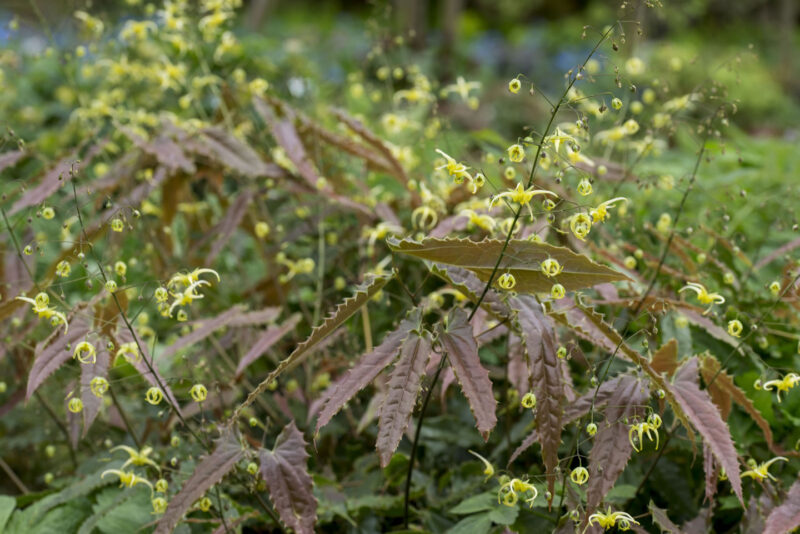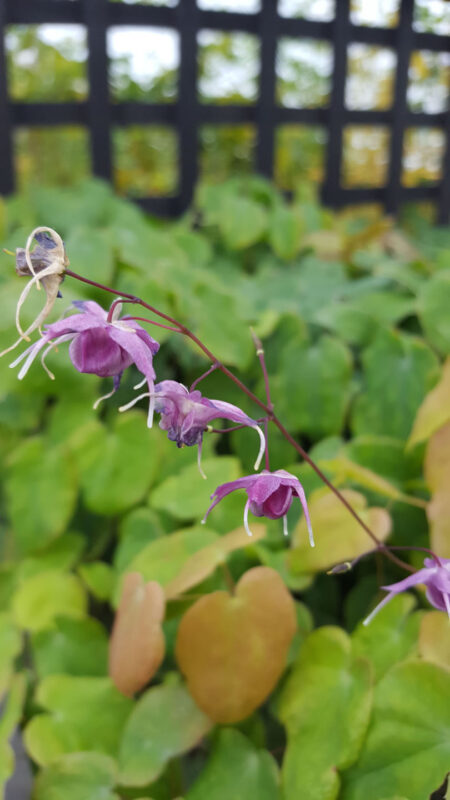My first encounter with this amazing range of plants started in the 80’s but developed in earnest about 20 years ago, when we moved to a much larger garden, which had a lot of shade, sited on green sand. We also had a much smaller budget due to the matching ratio of garden to mortgage!
So, being a member of the Kent group and having access to the plant sales table at meetings was hugely useful, and amongst many plants that were there to be found, was Epimedium x warleyense ‘Orangekonigen’ which is still growing happily in my garden today. Prior to the move I had started a fledgling nursery, which I ran alongside a ‘proper’ job, and by attending plant fairs I managed to find a few more varieties. I was tempted by their colour range, in addition to their foliage and resilience, which has never failed to impress me. They fitted nicely with the nursery which was slowly moving towards a shade loving perennials, specialism.

Epimedium ‘Kodai Murasaki’
A turning point was making the acquaintance of, and later, becoming friends with, one of Europe’s leading epimedium growers, and breeder, Koen van Poucke, on our twice yearly visits to Beervelde Plant Fair in Ghent, Belgium. He helped and guided me through recommending varieties that he rated highly and gave advice on how best to grow them.
Moving on a few years to 2012 I was in the fortunate position to take early retirement from my ‘proper’ job and fulfil my wish to run our nursery full (ish) time. In doing so, I built up confidence to do displays of shade loving plants at the RHS Spring Fair shows in the Lindley Hall, Westminster, and these highlighted many Epimedium. At one of these events in 2017, I was approached by the Chair of the RHS Herbaceous Committee who advised that they were setting up a Round Table forum to review and recommend AGM’s (Awards of Garden Merit) and would I invite other specialists and consider being Chair! I was very flattered to be asked, and definitely felt it was above my ‘pay grade’ but said yes. Round Table forums are used by the RHS when it is impractical to have a full 3 year trial, and where there is a current lack of AGM’s (at the time there were only 6) and there is a need for a review.

Epimedium ‘Pink Champagne’
This was very timely, as over the last 20 years the number of Epimedium’s available has risen from around 10 (mainly species) to approaching 400. This has been due to people like Darryl Probst in the States and Mikinori Ogisui in Japan, finding and distributing new species from mainly China and surrounding areas. In addition, Epimedium’s are remarkably promiscuous, and nursery owners, in addition to those mentioned above, like Robin White, Dr Julian Sutton, Elizabeth Strangman, Keith Wiley and in France, Thierry Delabroye have taken these new species and crossed them with others, new and old, and produced and more importantly, selected, some wonderful hybrids. Unfortunately, a lot of others have been produced and named, which are less wonderful, or, are very similar those currently available.
So, with not a little trepidation, a committee of, Dr Julian Sutton (formerly of Desirable Plants), Mr Roger Sutton, (National Collection Holder), Mr Koen van Poucke, Ms Sally Gregson (Author of Plant Lovers Guide to Epimedium), Mr Quentin Stark (Head Gardener, Hole Park), Mr James Miller (RHS Wisley) and myself and kept on track by RHS Coordinator Kirsty Angwin, met on April 20th at the home of the National Collection Holder. It was a fascinating day, and despite there being a roomful of Epimedium enthusiasts, from a short list of approximately 100 forms (one of the criteria for selection is availability) only 15 AGM’s were awarded, and of the 6 existing, 5 were rescinded, and only 1 reconfirmed.

Epimedium ‘Red Maximum’
I suspect that the majority of members who grow the older species like E. x warleyense, E. x perralchicum, E. x versicolor, E. alpinum, E. pinnatum and their named forms, and subspecies, think of them, as they should, as very useful plants, providing good ground cover. This is mainly due to their rhizomatous nature, generally forming a very woody root structure, which in turn makes them pretty drought tolerant. The forum (whose comment extracts are summarised in italics below) were mindful of how much this makes them useful garden plants, for difficult conditions. With this in mind AGM’s were awarded to E. x rubrum ‘A good tough plant. Provides good ground cover for a large area. Hardy and reliable. Strong doer without becoming invasive in dry shade’. E. x versicolor ‘Sulphureum’ ‘Reliable in deep shade, tough as old boots and has good young foliage’. Re-confirmed was E. pinnatum subsp. colchicum ‘Good evergreen ground cover for large areas. Excellent and a good doer, works well in dry shade’. A hybrid from Julian Sutton (ironically I purchased this from Coen Jansen in the Netherlands) that also falls into this category E. ‘Winter’s End’ ‘Early flowering with flowers above leaves. Tolerant of bad conditions.’.
As mentioned above, the slight drawback some of the above have, is that the old foliage needs shearing back (I suggest January, or even when you cut back hellebore foliage), preferably before new growth starts. You will be doubly rewarded by flowers not being obscured by old foliage, and followed by fresh new foliage, often, beautifully patterned. If you leave it too late, it is very fiddly to cut out old, avoiding new, growth, as I know to my cost!

Epimedium ‘Spine Tingler’
One well known species and its forms, which doesn’t have this problem, are the E. grandiflorum forms as they are deciduous. This species, which is more clump forming in habit, has the largest number of named varieties and all 4 of the E. grandiflorum that previously had AGM’s had them rescinded. E. grandiflorum itself was one, and it was withdrawn as it was felt to be ‘too variable, both in cultivation, and in the wild’. The other varieties were generally felt to be superseded by better ones. Those being E. g. ‘Akagi Zakura’ It’s name meaning ‘Cherry blossom from the Mountain Akagi’ and is a unique shade of pastel pink and apricot, above light green foliage. Comments were ‘Stunning plant and a new colour break’. From Daryll Probst in 2006 E. g. ‘Circe’ this is a tall form with flowers of purple-red sepals covering white tipped petals on red stems, held over dusky purple young leaves, remarkably tall, and I and others suspect is a hybrid, hence the Forum Comment ‘One of the best reds, a good plant. A new US hybrid, easy, vigorous and healthy’. The hybrid E. ‘Kodai Murasaki’ ‘Reddish-purple with white spurs, a good plant’ on tall (70cm) almost black stems, although at the same height as the light young foliage the flowers shine through. Despite having what is suspected to be E. grandiflorum as a parent it seems indifferent to the PH of the soil, and its worth noting that, the E. grandiflorum forms have a marked preference to acid (or below 6.5ph) soils.

Epimedium ‘Winters End’
Other varieties of newish (or more interesting) species were also given AGM’s. It is important to emphasise here that nearly all of these are quite different in their habit, to the garden stalwarts mentioned in the first part of this article. These are decorative plants, happy in dappled shade, but do not thrive in parched conditions. They are not shrinking violets either (as someone who has violets in their garden that saying is a bit of a misnomer!) and they will hold their own in normal soils, and are not fussy as to acid or alkalinity. I’ll start with E. acuminatum ‘Night Mistress’ which has enjoyed a recent, and deserved rise in popularity ‘Distinctive colour and an excellent form. Compact dark form and a good doer. Spectacular contrasting flowers’. These flowers have light, dusky pink sepals, over-arching deep purple, black spurred petals which are larger than the species. The delicate looking E. fargesii ‘Pink Constellation’ with ballerina-like flowers, more intensely coloured than species, of beautiful lilac-pink sepals, flaring over spurless purple petals, with anthers and stamens pirouetting below. These contrast charmingly with bronze-tinted slender young foliage. ‘Much admired, the public seem to like it. One of the best and sells well.’ Another that contrasts well with its young foliage, is E. franchetii ‘Brimstone Butterfly’ ‘Large attractive pale yellow flowers, and has attractive young leaves. Robust, easy and healthy’. The young leaves are large, almost salmon-pink, ageing green.
This brings us to the hybrids, all of outstanding disposition, and long interest. E. ‘Amber Queen’ ‘Outstanding variety, with large flower spikes. One of the most striking and floriferous’. Introduced by Robin White this has some of the longest flower spikes I’ve seen, I can remember taking a stem to a talk that was nearly a metre in length, and bears flowers of apricot sepals over cream spurred petals that deepen to an orange mouth. The young green leaves are slightly spiny and attractively speckled burgundy when young. The unusual combination of colours of the flowers of E. ‘Domino’ a Daryll Probst introduction in 2004, appealed to the forum too. ‘Floriferous with a lovely flower and grows well in garden and in pots’. A haze of creamy-pink and dark rose flowers dance on tall (60cm 24”) dark red stems, with attractive maroon marking on fresh green leaves. This next form, for me, is my ‘Desert Island’ epimedium, if I could only have one, this would be it!

Epimedium grandiflorum ‘Lillafe’
A Darryl Probst introduction, E. ‘Pink Champagne’ ‘A fabulous plant and an outstanding cultivar. Distinct pink flowered US hybrid becoming popular. Very good indeed, a vigorous plant and will repeat flower if established and happy’. The attractive flowers are held well above the foliage, and will reliably flower for about 10 weeks. The foliage has a lovely bronze tinge when young set off by red speckling, a beautiful combination. The next two are both introductions from Koen van Poucke and are one’s he feels are his best work. E. ‘Red Maximum’ ‘Brilliant plant, one of our favourites, very good red flowers. Strong, healthy and good red flowers’. Deep cranberry red sepals, over pale pink petals tipped white, with a dark pink stain to the mouth, on tall brown-pink stems held above young bronze-burnished leaves, ageing green. One of his most recent and most striking introductions, and I think will be one of the most popular, is E. ‘Royal Purple’ ‘Outstanding form, grows well’. Remarkably tall stems bear carmine-pink sepals and spurs, deepening to intense purple-red mouths on large flowers. These are borne high above mottled pink and green young foliage. Last AGM, and by no means least is another of Daryll Probst introductions E. ‘Spine Tingler’ ‘Good foliage and flowers. Spiny leaved evergreen a reliable plant. Great serrated evergreen foliage and bright yellow flowers’. The flowers are a combination of palest lemon, to deep sulphur, whilst not being an unusual colour in the world of Epimedium, they are above, and contrasting with, fabulous foliage. Leaves that are long, tapering spear-shaped, spiny edged, and slightly undulating, and which grab your attention.
In summary the features that make these plants so garden worthy, is not only the length and variety of their flowering but the beauty and interest that their foliage has to offer, extending their value to the gardener. The committee were aware that they had really just scratched the surface with the varieties selected above. All of us, had other good candidates for awards, but generally, only due to lack of availability were these held back. Hopefully, next time, we’ll be able to have a full three year trial. I believe we shall be seeing a lot more Epimediums in the future.
Victoria Mummery
Plant Fairs Roadshow
1 Beechbridge Cottages
Goudhurst Road
Marden
TN12 9NN